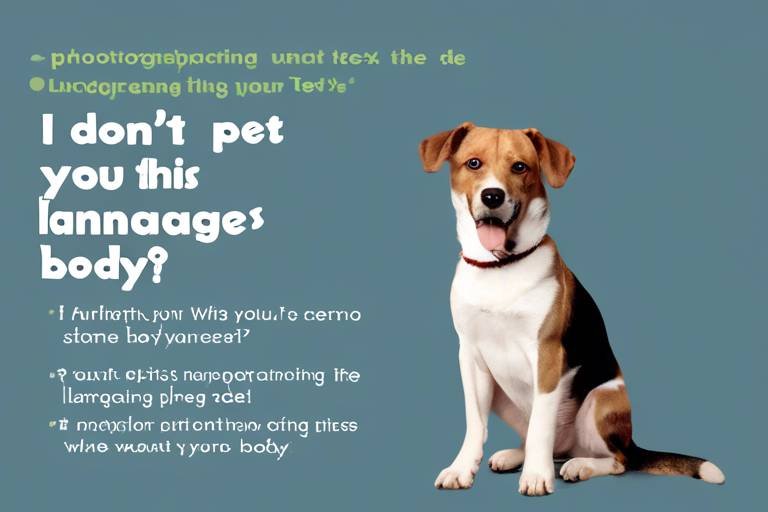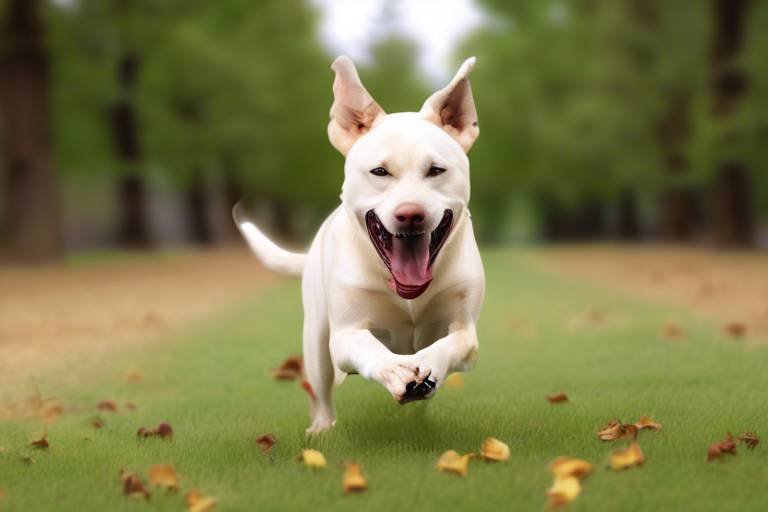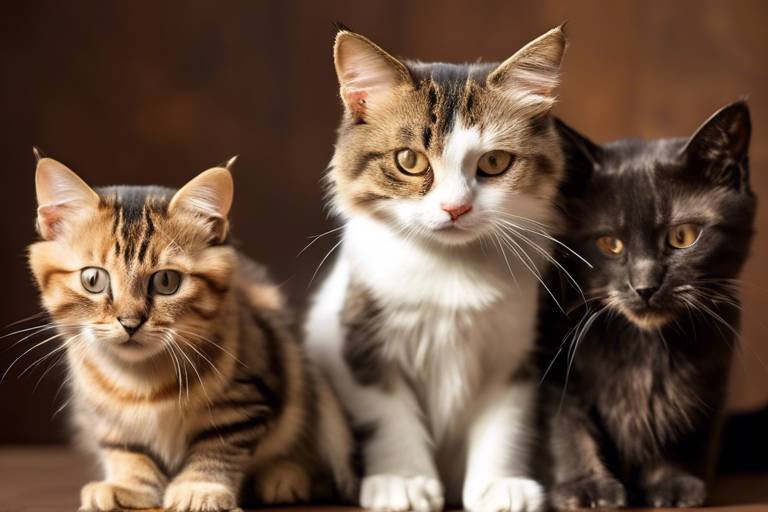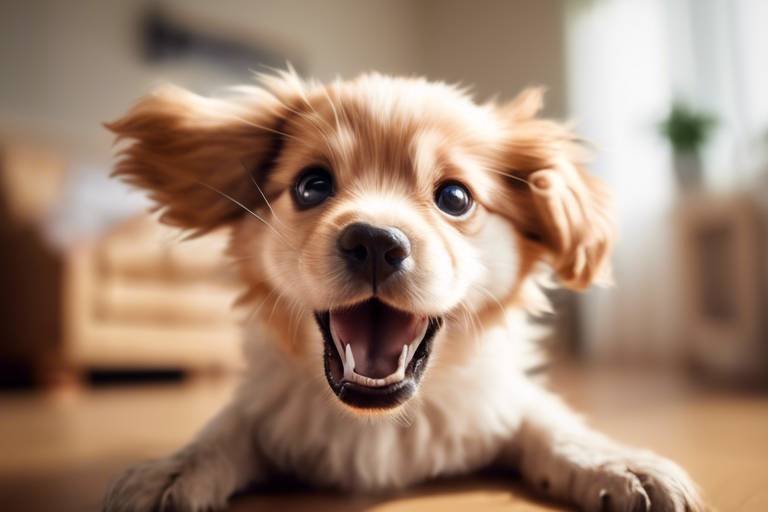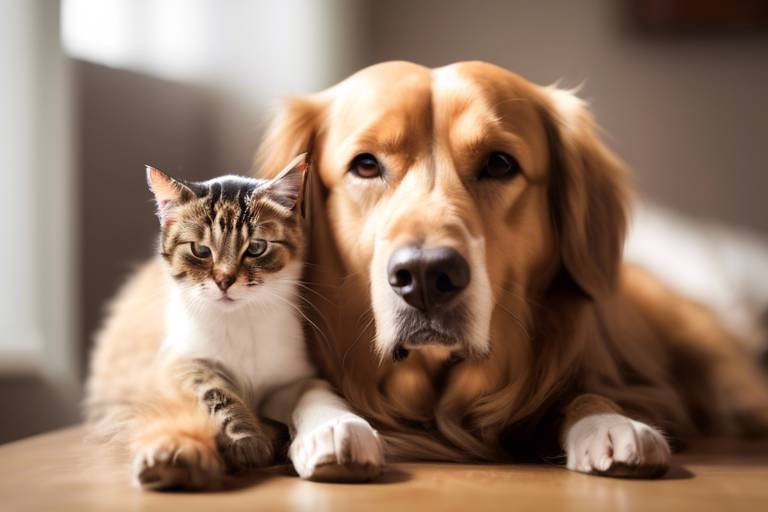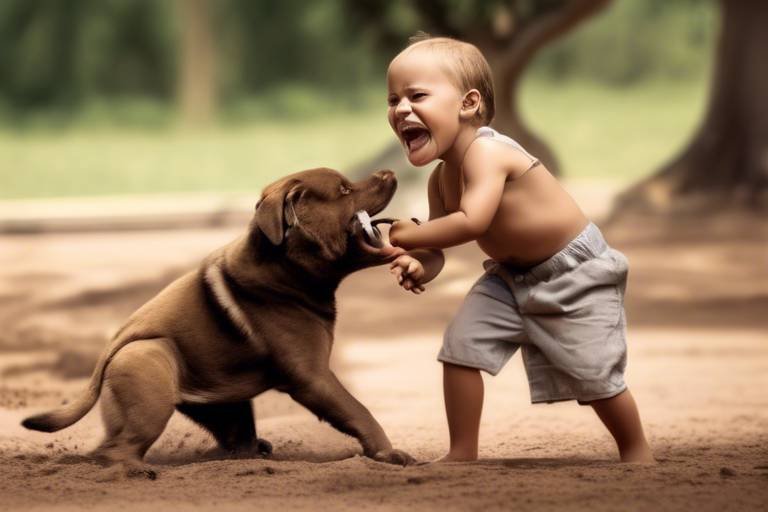Understanding Your Pet’s Body Language
Have you ever wondered what your furry friend is trying to say? Just like humans, pets have their own unique ways of expressing their feelings and needs. is key to building a stronger bond and ensuring a happy life together. This article delves into the fascinating world of pet communication, focusing on how dogs and cats convey their emotions through physical cues. By learning to interpret these signals, you can respond more effectively to your pet's needs, leading to a more harmonious relationship.
Imagine this: you come home after a long day, and your dog races to the door, tail wagging furiously. You can feel the excitement radiating from them, but what does it all mean? Similarly, when your cat curls up next to you, is it simply seeking warmth, or is it a sign of affection? These moments are not just fleeting interactions; they are opportunities to connect on a deeper level with your pets. By tuning into their body language, you can enhance your understanding of their emotions and behaviors.
Body language is crucial for pet owners because it serves as a window into their emotional world. It allows you to identify when your pet is feeling happy, anxious, or even aggressive. For instance, a dog that cowers with its tail tucked between its legs is likely feeling scared, while a cat that purrs and kneads your lap is expressing contentment. Recognizing these signs can help prevent behavioral issues and health concerns, ensuring your pet feels safe and loved.
Moreover, understanding body language is not just about interpreting negative behaviors; it’s also about celebrating the positive ones! When your dog greets you with a joyful bark and a wagging tail, or when your cat playfully swats at a feather toy, these are moments to cherish. They indicate that your pet is engaged and happy in their environment. By being aware of these signals, you can create a more enriching and fulfilling life for your furry companions.
In conclusion, the ability to understand your pet's body language is invaluable. It fosters a deeper connection between you and your pet, enhances communication, and ultimately leads to a happier, healthier relationship. So, the next time you’re with your pet, take a moment to observe their body language. You might just discover a whole new way to connect!
- What are some common signs of a happy dog? Look for a wagging tail, relaxed body posture, and playful behavior.
- How can I tell if my cat is stressed? Signs of stress in cats include hiding, flattened ears, and excessive grooming.
- Why is it important to understand my pet's body language? Understanding body language helps you respond to your pet's needs, preventing behavioral issues and enhancing your bond.

Why Body Language Matters
Understanding body language is crucial for pet owners who want to build a strong bond with their furry companions. Just like humans, pets communicate their feelings and needs through various gestures, postures, and movements. By paying attention to these signals, you can gain insight into your pet's emotional state, helping you respond appropriately to their needs. This not only fosters a deeper connection but also ensures a harmonious relationship between you and your pet.
When you comprehend your pet's body language, you can identify emotions such as happiness, anxiety, or aggression. For instance, a dog wagging its tail might be excited to see you, while a cat with flattened ears could be feeling threatened. Recognizing these signs can prevent misunderstandings, leading to a more peaceful coexistence. Moreover, understanding your pet's signals can help you identify potential behavioral issues or even health concerns that might require attention.
Consider this: if your dog is constantly barking or your cat is hiding, these behaviors might be their way of expressing discomfort or fear. By learning to interpret these signs, you can take proactive steps to address any issues, ensuring your pets feel safe and loved in their environment. This not only improves their quality of life but also enhances your experience as a pet owner.
In addition, understanding body language can help you become a more responsible pet owner. For example, if you notice your dog displaying signs of aggression, it’s vital to manage the situation carefully to avoid accidents. By recognizing these signals early on, you can take the necessary precautions to keep both your pet and others safe.
Ultimately, the better you understand your pet’s body language, the more fulfilling your relationship will be. You’ll be able to respond to their needs promptly, creating an environment where they feel secure and understood. So, the next time you interact with your pet, take a moment to observe their body language—it might just reveal more than you expect!
- How can I tell if my dog is happy? Look for a wagging tail, relaxed posture, and playful behavior. A happy dog often shows enthusiasm in their movements.
- What does it mean if my cat's ears are flat? Flattened ears typically indicate that your cat is feeling threatened or aggressive. It's best to give them some space.
- Why is it important to understand my pet's body language? Understanding your pet's body language helps you respond to their needs effectively, improving your relationship and ensuring their well-being.

Common Dog Body Language Signs
Dogs are incredibly expressive creatures, and their body language is rich with meaning. By understanding the signs they display, pet owners can gain valuable insights into their dog's emotional state and needs. For instance, a dog that is happily wagging its tail is likely feeling excited and content. However, not all tail wags are created equal; the nuances in tail movement can tell you a lot about what your pup is really feeling. Recognizing these signs is essential for fostering a strong bond with your furry friend.
One of the most telling aspects of a dog's body language is the position and movement of their tail. A wagging tail is often seen as a universal sign of a happy dog, but did you know that the speed and height of the wag can indicate different emotions? For example, a high, fast wag is usually a sign of joy, while a slow wag might suggest hesitation or uncertainty. Conversely, a lowered tail that is tucked between the legs can indicate fear or submission, signaling that your dog may feel threatened or insecure.
Understanding tail wagging is just the tip of the iceberg when it comes to canine communication. For instance, a stiff, high-held tail can be a clear indicator of aggression or dominance. If you notice your dog exhibiting this behavior, it’s important to approach the situation with caution. Recognizing these signs can help prevent potential conflicts, especially during interactions with other dogs or new people.
In addition to tail movement, dogs also communicate a great deal through their facial expressions. A relaxed face, with soft eyes and a slightly open mouth, generally indicates that your dog is comfortable and happy. On the other hand, a tense jaw, narrowed eyes, or a wrinkled forehead may suggest that your dog is stressed or feeling threatened. Learning to read these facial cues can significantly enhance your ability to respond appropriately to your dog's needs.
Moreover, it’s not just about the tail and face; dogs express themselves through their entire body. A dog that stands tall with its head held high and a relaxed stance is likely feeling confident and secure. However, if your dog is crouched low to the ground with a lowered head, it may be feeling anxious or fearful. Understanding these subtle cues can help you create a more nurturing environment for your pet.
In summary, recognizing common dog body language signs is crucial for any pet owner. By paying close attention to your dog's tail position, facial expressions, and overall posture, you can better understand their feelings and needs. This not only enhances your relationship but also ensures a safer and more harmonious living environment for both you and your furry companion.
- What does it mean when my dog’s tail is wagging? – A wagging tail generally indicates happiness, but the speed and height can reveal more about their emotional state.
- How can I tell if my dog is feeling aggressive? – Signs of aggression may include a stiff, high-held tail, bared teeth, and a tense body posture.
- What should I do if my dog shows signs of fear? – If your dog appears fearful, it’s best to give them space and comfort them in a calm manner.
- Can dogs communicate with their eyes? – Absolutely! Dogs use their eyes to convey emotions; soft eyes indicate comfort, while narrowed eyes can signify stress.
Tail Position and Movement
When it comes to understanding your dog's emotions, are among the most telling signs. Just like how we use our facial expressions to convey feelings, dogs communicate a wealth of information through their tails. A wagging tail doesn’t always mean a happy pup; in fact, the way a dog wags its tail can tell you a lot about its current emotional state. For instance, a tail that is held high and wagging rapidly often indicates excitement or joy, as if the dog is saying, "Hey, look at me! I'm so happy to see you!" On the other hand, a tail that is tucked between the legs is a clear sign of fear or submission, suggesting that the dog may be feeling threatened or anxious.
It's important to note that the speed and height of the wag can also provide clues. A quick, high wag is typically a sign of a confident and happy dog, while a slow wag at a lower position can indicate uncertainty or hesitation. Think of it like a flag: the higher and more vigorously it waves, the more positive the message. Conversely, a low and slow wave can mean the opposite. Additionally, if the tail is held stiffly and is not moving, this could indicate that the dog is on high alert, possibly feeling threatened or aggressive. Recognizing these subtle differences can help you respond appropriately to your dog's needs.
To help you visualize these different tail positions and their meanings, here’s a simple table:
| Tail Position | Meaning |
|---|---|
| High and Wagging | Excitement or happiness |
| Low and Slow Wagging | Uncertainty or hesitation |
| Tucked Between Legs | Fear or submission |
| Stiff and High | Aggression or threat |
In addition to tail movements, observing how your dog interacts with its environment while wagging its tail can provide further insights. For example, if your dog is wagging its tail but also showing signs of aggression—such as growling or showing teeth—it’s crucial to take a step back and assess the situation. Understanding that context is key; a wagging tail can be a sign of friendliness, but it can also accompany a warning.
Ultimately, taking the time to observe your dog's tail movements in various situations can significantly enhance your ability to understand their feelings and needs. Just like we interpret the tone of voice in human communication, learning to read your dog's tail can help you build a stronger bond with your furry friend, ensuring that both of you can enjoy a happy and fulfilling relationship.
- What does it mean if my dog's tail is wagging but their body is tense? This could indicate that your dog is feeling conflicted or anxious. It's essential to observe other body language signs to understand their emotional state better.
- Can a dog's tail position change quickly? Yes! Dogs can change their tail position rapidly based on their environment or interactions, so always pay attention to the context.
- Is tail wagging universal among all dog breeds? While most dogs wag their tails to communicate, the meaning can vary slightly among different breeds, so it's important to consider individual personality traits.
Understanding Tail Wagging
When it comes to our furry friends, the tail is like a built-in communication device. It’s fascinating how a simple wag can convey a multitude of emotions! For instance, a dog that is wagging its tail vigorously while jumping up and down is likely bursting with joy, eager to greet you after a long day. On the other hand, if the wagging is slow and low, it may indicate uncertainty or submission. Isn’t it amazing how much they can express without saying a word?
To truly understand what your dog is trying to communicate, you need to consider the speed and height of the wag. Here’s a quick breakdown:
- Fast, High Wag: This usually signifies excitement and happiness. Your dog is thrilled to see you or is ready to play!
- Slow Wag: A slow wag can suggest that your dog is feeling unsure or cautious about a situation.
- Wagging with a Stiff Tail: If the tail is wagging but held high and stiff, it might indicate that your dog is feeling aggressive or on alert.
Additionally, the direction in which the tail wags can also provide clues. A tail wagging to the right often indicates positive feelings, while a wagging tail to the left may suggest negative emotions. This is a fascinating area of study in canine behavior, and it shows just how nuanced their communication can be.
So, the next time you see your dog wagging its tail, take a moment to observe the context and the accompanying body language. By doing so, you’ll not only deepen your understanding of your pet’s feelings but also strengthen the bond you share. After all, communication is a two-way street, and the better you understand your dog, the more fulfilling your relationship will be!
- What does it mean if my dog wags its tail but seems tense?
If your dog is wagging its tail but appears tense or has a stiff body, it could be feeling anxious or threatened. It's important to assess the situation and ensure your dog feels safe. - Can a dog wag its tail when it's angry?
Yes, a dog can wag its tail when it's angry or aggressive. A high, stiff wag often indicates that the dog is on alert and may be preparing to defend itself. - How can I tell if my dog's wagging is happy?
A happy dog typically has a relaxed body posture, a wagging tail that is high and fast, and may even have a playful demeanor. Look for other signs of happiness, such as a relaxed face and playful behavior.
Signs of Aggression
Recognizing the in dogs is crucial for any pet owner. Aggression can manifest in various ways, and being able to identify these signs can help prevent dangerous situations for both the dog and those around it. One of the primary indicators of a dog’s aggressive state is its tail position. A stiff, high-held tail is often a clear warning sign that the dog is feeling threatened or is ready to confront a perceived danger. This posture is a signal that the dog may be preparing to defend itself or assert dominance.
In addition to tail position, other physical cues are equally important. For instance, a dog that displays a tense body posture, with its muscles rigid and its stance wide, is often on high alert. This tension can be accompanied by a growl, which serves as an audible warning to others to back off. Furthermore, the dog’s mouth can also provide significant clues; if a dog is showing its teeth or has its lips curled back, it’s a clear indication of aggression. It’s essential to pay close attention to these signals, as they can escalate quickly if not addressed.
Another critical aspect to consider is the dog’s eye contact. A dog that stares intently without blinking can be displaying a challenge or a threat. Conversely, if a dog is avoiding eye contact while showing other signs of aggression, it may be feeling conflicted or fearful. Understanding these subtle differences can be vital in assessing the situation accurately.
To help you further understand the signs of aggression, here's a quick reference table summarizing the key indicators:
| Sign | Description |
|---|---|
| High Tail | A stiff, high-held tail indicates a dog is feeling aggressive or threatened. |
| Tense Posture | Rigid muscles and a wide stance suggest the dog is on alert and ready to confront. |
| Growling | A low growl serves as a warning to others to stay away. |
| Showing Teeth | Exposed teeth or curled lips indicate a dog is feeling aggressive. |
| Intense Staring | A fixed stare without blinking can signal a challenge or threat. |
In summary, being aware of these signs of aggression is essential for ensuring the safety of both your dog and those around it. If you notice any of these behaviors, it’s wise to take a step back and reassess the situation. Sometimes, providing your dog with a calm environment or removing them from a stressful situation can help alleviate their aggressive tendencies. Remember, understanding your pet's body language is the first step toward a harmonious relationship.
- What should I do if my dog shows signs of aggression?
If your dog displays aggressive behavior, it’s best to consult a professional dog trainer or behaviorist who can offer tailored advice and training strategies. - Can aggression be trained out of a dog?
Yes, with proper training techniques and consistent reinforcement, many dogs can learn to manage their aggressive tendencies. - Are certain breeds more prone to aggression?
While any dog can show aggression, some breeds may have a predisposition to protective behaviors. However, individual temperament and upbringing play a significant role.
Facial Expressions in Dogs
Dogs are incredibly expressive creatures, and their facial expressions play a vital role in how they communicate with us and with each other. Just like humans, dogs can convey a wide range of emotions through their faces, and being able to interpret these expressions is essential for building a strong bond with your furry friend. Have you ever noticed how your dog seems to "smile" when you come home? Or how their face changes when they see a stranger? These subtle cues can tell you a lot about what your dog is feeling at any given moment.
One of the most common facial expressions you'll encounter is the relaxed face. When a dog feels safe and comfortable, their face will typically have a soft appearance. The mouth may be slightly open, and the eyes will be bright and relaxed. This is the dog equivalent of a smile! On the other hand, if you see a dog with a tense jaw and narrowed eyes, it could be a sign of stress or aggression. This contrast in expressions highlights the importance of being aware of your dog's feelings, as misunderstandings can lead to unnecessary conflict.
To help you better understand your dog's facial expressions, here are some key signs to look out for:
- Relaxed Face: Soft mouth, bright eyes, and a slightly open mouth.
- Alert Face: Ears perked up, eyes wide, and mouth closed.
- Stressed Face: Tense jaw, narrowed eyes, and ears back.
- Playful Face: Relaxed mouth, wagging tail, and a "play bow" posture.
Understanding these facial expressions can help you respond appropriately to your dog's needs. For example, if your dog is showing signs of stress, it might be best to give them some space or try to identify the source of their discomfort. Conversely, if they're showing a relaxed face, it's a great opportunity for some quality bonding time! By paying attention to these subtle cues, you can enhance your communication and strengthen the relationship you share with your canine companion.
Q: How can I tell if my dog is happy?
A: A happy dog often has a relaxed face, wagging tail, and may even "smile" with a slightly open mouth. Their body language will also be loose and playful.
Q: What does it mean if my dog is growling?
A: Growling can indicate a variety of emotions, from playfulness to aggression. Pay attention to their body language and context; a relaxed body may mean they are playing, while a stiff posture could indicate fear or aggression.
Q: Can dogs express sadness?
A: Yes, dogs can show signs of sadness or depression. This may manifest as a lack of energy, changes in eating habits, or a withdrawn demeanor. If you notice these signs, it's important to consult a veterinarian.
Q: How can I improve my dog's emotional health?
A: Regular exercise, playtime, and socialization are essential for a dog's emotional well-being. Providing a safe and loving environment also helps your dog feel secure and happy.

Understanding Cat Body Language
When it comes to our feline friends, understanding their body language is like deciphering a secret code. Cats are often seen as mysterious creatures, and their ways of communicating can be subtle yet profound. By paying attention to their body language, you can unlock a deeper understanding of your cat's feelings and needs, leading to a more fulfilling companionship. Just like humans, cats express their emotions through various physical cues, and recognizing these signals can enhance the bond you share.
One of the primary ways cats communicate is through their tail position. An upright tail is typically a sign of a happy and confident cat, while a tail that is low or tucked between the legs can indicate fear or submission. Additionally, a cat may express agitation or annoyance by swishing its tail back and forth vigorously. This is a clear warning that they are not in the mood for interaction. On the other hand, a gently waving tail can signify curiosity or playful intent. It’s essential to observe these nuances to gauge your cat's mood accurately.
Another significant aspect of cat body language is the position of their ears. Ears that are pointed forward show that your cat is alert and engaged, while ears that are flattened against the head can indicate fear, aggression, or irritation. It’s fascinating how much information you can gather just by observing these small details. For instance, if your cat’s ears are flicking back and forth, it might be feeling conflicted or unsure about a situation. Understanding these signals can help you respond appropriately to your cat's needs.
Body posture also plays a crucial role in feline communication. A cat that is lying on its back with its belly exposed is often displaying trust and comfort in its environment. However, this doesn’t always mean they want a belly rub; many cats have a defensive mechanism that kicks in when they feel vulnerable. Conversely, if a cat is crouched low with its back arched, it may feel threatened or scared. Recognizing these postures can help you create a safe space for your furry companion.
Moreover, cats have a unique way of using their whiskers to communicate. When a cat's whiskers are extended and forward, it shows curiosity or excitement. In contrast, whiskers that are pulled back can indicate fear or discomfort. It’s amazing how these small facial features can convey such a wide range of emotions!
To further illustrate the intricacies of cat body language, here’s a quick reference table:
| Body Language Cue | Meaning |
|---|---|
| Upright Tail | Happy and confident |
| Low or Tucked Tail | Fear or submission |
| Flattened Ears | Fear or aggression |
| Arched Back | Threatened or scared |
| Exposed Belly | Trust (but may not want to be touched) |
In conclusion, understanding your cat's body language is essential for nurturing a happy and healthy relationship. By being observant and responsive to their cues, you can ensure that your feline friend feels safe and loved in your home. Remember, every cat is unique, and their body language may vary slightly based on individual personality and experiences. So, take the time to learn your cat's specific signals, and you'll find that your bond will only grow stronger.
- How can I tell if my cat is happy? Look for signs like an upright tail, relaxed body posture, and slow blinking.
- What does it mean if my cat's ears are flicking? This usually indicates that your cat is feeling agitated or conflicted about something.
- Why does my cat knead with its paws? Kneading is a comforting behavior that cats often exhibit when they feel safe and happy.
- How can I make my cat feel more secure? Provide a safe space, use gentle tones, and respect their personal boundaries.
Tail and Ear Position
When it comes to understanding your feline friend, observing their tail and ear positions is absolutely crucial. Just like humans have their own unique ways of expressing emotions, cats have developed a sophisticated language of their own, primarily communicated through their body language. For instance, an upright tail is often a telltale sign of a happy and confident kitty, strutting around like they own the place. On the flip side, when a cat's ears are flattened against their head, it's a strong indicator that they might be feeling threatened or aggressive. This duality of expression is essential for any cat owner to grasp in order to foster a trusting and secure environment.
To further illustrate this, let’s break down the meanings behind different tail and ear positions:
| Tail Position | Ear Position | Emotional State |
|---|---|---|
| Upright | Forward | Happy and Curious |
| Curled | Neutral | Content and Relaxed |
| Flat against body | Flattened | Fearful or Aggressive |
| Slowly waving | Sideways | Unsure or Anxious |
Understanding these signals not only enhances your relationship with your cat but also helps you create a safe space for them. Imagine walking into a room and immediately sensing the mood based on your cat’s body language. It’s like having a secret code that only you and your furry buddy understand! This knowledge can prevent misunderstandings and help you respond appropriately to your cat's needs.
Moreover, recognizing these subtle cues can be a game-changer in multi-pet households. If you have other animals, understanding your cat's body language can help you manage interactions and prevent potential conflicts. For instance, if you notice your cat's tail twitching and ears pinned back while another pet approaches, it’s a good idea to intervene. After all, we all want our pets to feel safe and comfortable, right?
So, the next time you find yourself watching your cat, take a moment to observe their tail and ear positions. You might just discover a whole new world of communication that deepens your bond and enriches your understanding of your beloved pet.
- What does it mean when my cat's tail is puffed up? A puffed-up tail typically indicates that your cat is feeling threatened or scared. It's their way of trying to appear larger to potential threats.
- How can I tell if my cat is happy? Look for an upright tail, relaxed ears, and a contented expression. Purring and kneading are also good signs of a happy cat!
- Why does my cat's tail twitch when they are watching something? This is often a sign of excitement or concentration. Your cat is likely focused on a potential prey or something that has caught their interest.
Body Posture and Movement
When it comes to understanding our feline friends, play a crucial role in deciphering their emotions and intentions. Cats are incredibly expressive creatures, and their body language can tell us a lot about how they feel at any given moment. For instance, a cat that is feeling confident and relaxed will often exhibit an open posture, with their body facing you and their tail held high. This is a clear sign of comfort and trust, making it an ideal time for some affectionate petting!
On the other hand, if you notice your cat arching its back and puffing up its fur, it’s likely feeling threatened or scared. This defensive posture is a way for cats to make themselves appear larger to potential threats. It's essential to recognize this sign, as approaching a cat in this state could lead to a defensive reaction, such as hissing or swatting. Understanding these subtle cues can help you avoid uncomfortable situations for both you and your pet.
In addition to posture, the way a cat moves can provide insights into its mood. For example, a cat that is playfully stalking its toy will move with a slow, deliberate gait, showcasing its hunting instincts. Conversely, if a cat is suddenly darting around the room, it may be experiencing a burst of energy known as the "zoomies," which is often a sign of joy or excitement. Recognizing these playful movements can enhance your interactions, allowing you to engage in playtime that satisfies their natural instincts.
To further illustrate these points, here’s a quick reference table of common cat postures and what they might mean:
| Posture/Movement | Interpretation |
|---|---|
| Tail held high | Happy and confident |
| Arched back | Feeling threatened or scared |
| Slow, deliberate movements | Playful and engaged |
| Flattened ears | Fearful or aggressive |
By paying attention to these body postures and movements, you can develop a deeper understanding of your cat's emotional state. This knowledge not only helps in building a stronger bond with your pet but also ensures that you can respond appropriately to their needs. Whether they’re feeling playful, anxious, or relaxed, being attuned to their body language allows for a more harmonious relationship.
- Q: How can I tell if my cat is happy?
A: Look for a relaxed body posture, a high tail, and slow blinking, which are all signs of a content cat. - Q: What does it mean if my cat’s tail is twitching?
A: A twitching tail can indicate excitement or agitation, depending on the context. Pay attention to other body language cues. - Q: Why does my cat knead with its paws?
A: Kneading is a comforting behavior that originates from kittenhood, often indicating that your cat feels safe and happy.
Frequently Asked Questions
- What are the key signs of a happy dog?
A happy dog often displays a relaxed body posture, a wagging tail, and a playful demeanor. You might notice them bouncing around, wagging their tail high, and even play bowing (front legs stretched out while the back end is up). These signs indicate that your furry friend is feeling joyful and comfortable in their environment.
- How can I tell if my dog is anxious?
An anxious dog may show signs like pacing, whining, or hiding. Their tail might be tucked between their legs, and they may avoid eye contact. If your dog seems restless or is excessively licking their lips, these could be signals that they are feeling stressed or uneasy.
- What does it mean when a dog growls?
Growling can be a form of communication for dogs. It can indicate discomfort, fear, or even playfulness, depending on the context. If your dog growls while playing, it might just be part of the fun. However, if they growl when approached while eating or resting, it’s a warning that they feel threatened and you should give them space.
- How do I interpret my cat's body language?
Cats communicate their feelings through various body signals. An upright tail usually means they are happy, while a puffed-up tail indicates they are scared or agitated. Pay attention to their ears; if they are pointed forward, your cat is likely curious, but if they are flattened against their head, it could mean they are frightened or angry.
- What does it mean when my cat kneads?
Kneading is a behavior that many cats exhibit, often referred to as "making biscuits." This action is typically a sign of contentment and comfort. Kittens knead their mothers to stimulate milk flow, and adult cats may knead when they feel safe and relaxed, often while snuggling with you or resting on a soft surface.
- Why does my dog tilt its head?
When dogs tilt their heads, it often indicates curiosity or confusion. They might be trying to understand a sound or a command better. This adorable behavior typically shows that your dog is engaged and interested in what you are saying or doing, making it a delightful way to bond with them.
- What should I do if my pet shows signs of aggression?
If your pet displays aggressive behavior, it’s essential to assess the situation carefully. Stay calm and avoid making sudden movements. Give your pet space and try to identify the cause of their aggression—whether it’s fear, territoriality, or pain. If the aggression persists, consider consulting a professional trainer or a veterinarian for guidance.
- How can I improve communication with my pet?
Improving communication with your pet involves observing their body language and responding appropriately. Spend quality time together, engage in play, and learn to recognize their signals. Positive reinforcement, like treats or praise when they display desired behaviors, can also strengthen your bond and enhance understanding.

